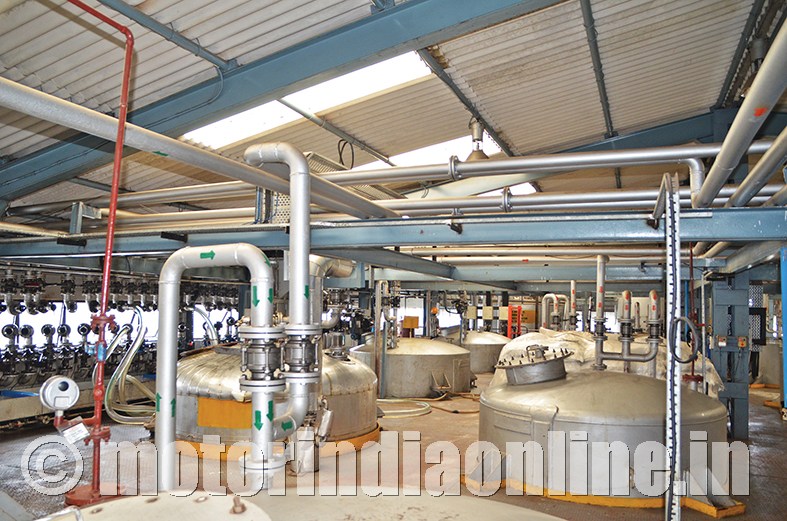There is increasing demand for automotive oil, lubricants and greases on account of surging vehicles on road and growing consumer awareness regarding the use and advantages of engine oils and other lubricants. There is a great deal of social awareness on part of oil and lubricant manufacturers as well as vehicle original equipment manufacturers (OEMs). The rising trend of partnerships between OEMs and lubricant manufacturing companies is testimony of environment awareness, consumer needs as well as technological advancements. These will augment demand for automotive lubricants in India over the next two to five years. “India’s automotive market is growing steadily with a market size of approximately 1.2 million metric tonnes and the annual growth is 2 to 3 per cent. We are gearing up for exciting times ahead,” stated Vinit Asher, Director, Raj Petro Specialties Pvt. Ltd.
With improved machining practices in the manufacturing of engine components, the trend today is to use thinner oils to achieve fuel economy benefits. This also help in reducing CO2 emission and help in the environmental concerns regarding greenhouse gas emission. “Out of 2.8 billion liters per year of total lubricants demand in India, 1.18 billion liters would be automotive lubricants and 770 million liters would be industrial oils, with the remaining being process oils. The market opportunity across the segments for heavy duty diesel engine oils would be 420 million liters per year, around 125 million liters per year for passenger cars, 235 million liters per year for motorcycle oils and 280 million liters per year for transmission & axle oils, across the vehicle segments,” believed Mr. Nandan Agrawaal.
Coping with emission standards
India is already preparing to leapfrog from the Bharat Stage (BS) IV emission norms, that are now in force, to the BS-VI norms by 2020. With the new regulations, there are a lot of technological changes that will occur in the vehicles which will have a significant impact on pricing of these vehicles as well as the way they function. Some of the major changes in the automobiles under the wake of BS-VI norms will be fitment of DPF (diesel particulate filter), SCR (selective catalytic reduction) module, etc. The focus of will also be on NOx (nitrogen oxide), sulphur and particulates. To cater to these technological changes, low SAPS (sulphated ash, phosphorous and sulphur) lubricants will have to be introduced to be compatible with after treatment devices.
The real challenge posed by Euro VI is in meeting the chemical requirements of modern after treatment devices which need low sulphated ash, phosphorus and sulphur (SAPS) oils. After treatment systems required for Bharat VI (Euro VI) engines will require oils with stringent chemical limits (e.g.: lower SAPS) and also higher performance characteristics. This will involve major changes in both additive technologies and base oil slates. Compared, to BS-IV emissions norms, the most significant change is a reduction in allowable NOx and hydrocarbon emissions. OEMs are still working to finalise their hardware strategies to meet these limits. “It is expected that gasoline vehicles will be able to comply by relatively minor changes to existing after treatment devices, e.g., more efficient three-way-catalysts. Diesel vehicles, however, will need to adopt more severe exhaust gas recirculation strategies and/or selective catalytic reduction equipment to meet the NOx limits while balancing hydrocarbon emissions. Diesel particulate filters will also be required in order to meet the particulate matter limits of the legislation. This technical challenge must be met in addition to remaining competitive in a very cost-conscious market and maintaining durability in some very demanding driving conditions,” informed Mr. Omer Dormen, Castrol India Ltd.
Technology at help
Advances in equipment technology impact the requirements from the lubricant. Companies recognise, but underestimate, potential savings from effective equipment lubrication. Even the best lubricant or grease cannot perform if it is not managed correctly. “Unlocking Total Cost of Ownership (TCO) savings hinges not just on selecting the right product but also ensuring that it is managed properly,” said Ms. Mansi Tripathy, Country Head, Shell Lubricants India.
There are huge lists of tests and product development processes that are taking place at various companies’ R&D centre. Products go through wider range of testing under extreme high and low temperatures. “To determine the performance of lubricants at starting a cold engine, the lubricants are tested in the cold-cranking simulator at low temperatures. This cranking test can be done up to -35°C depending on the grades. The mini rotary viscosity instrument, at the centre, is used for measuring low-temperature pumping viscosity up to -40°C depending upon the grades,” said Dr. Daya Shukla, Vice President, Technology & Quality Assurance, Zoomol.
Similarly, viscosity tests are also mandatory in high temperature and thus a very special test HTHS (high temperature high shear) is done to determine the viscosity of engine oils at actual performance of oils at high temperature in a running engine. The HTHS test, which runs using engine oil heated to 150°C and it is checked and observed that the oil should not lose its viscosity at 150°C. He added: “Oil that is too thin during the high temperature may not provide the needed lubricant protection, which could result in significant wear and tear in the engine parts.”
In, the following pages you will read about companies that are doing some exceptional work to bring high performance quality oil and lubricants and matching pace and in many cases going beyond the expectations. The objective of the feature is to identify & examine the developments, such as new product launches, expansion, long drain oils versus initial volumes, R&D technology at each company’s level and the impact it has in the demand-supply scenario of automotive lubricant market in India. Have a smooth, uninterrupted reading!
